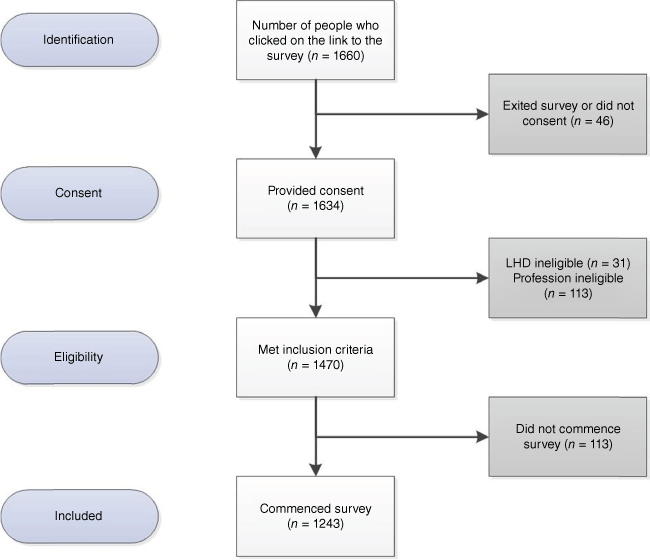Perceptions of research capacity in public health organisations: comparison of NSW metropolitan and non-metropolitan Local Health Districts
Nicole Raschke A * , Joanne Bradbury B and Jacqui Yoxall BA Mid North Coast Local Health District, Port Macquarie, NSW, Australia.
B Faculty of Health, Southern Cross University, Gold Coast, Qld, Australia.
Australian Health Review 46(6) 746-755 https://doi.org/10.1071/AH22100
Submitted: 19 June 2022 Accepted: 14 October 2022 Published: 18 November 2022
© 2022 The Author(s) (or their employer(s)). Published by CSIRO Publishing on behalf of AHHA. This is an open access article distributed under the Creative Commons Attribution-NonCommercial-NoDerivatives 4.0 International License (CC BY-NC-ND)
Abstract
Objective The aims of this study were to explore and compare the perceptions of research capacity and culture (RCC) in metropolitan and non-metropolitan New South Wales (NSW) Local Health Districts (LHDs).
Methods The Research Capacity and Culture Tool was delivered online to clinicians and health managers. A 10-point Likert scale of success or skill at organisational, team and individual level of research capacity was used. An independent t-test assessed differences in domain means between non-metropolitan and metropolitan LHDs.
Results A total of 1243 participants responded. Responses to the survey indicated the perception of individual’s research skills were greater than the perception of RCC at both the team and organisational levels. Participants from metropolitan locations had significantly higher mean scores across all three domains compared with non-metropolitan locations (P < 0.001).
Conclusion Results indicated the perception of individual’s research skills were greater than the team and organisational levels. Participants from metropolitan locations had significantly higher perceptions of RCC across all three domains compared with non-metropolitan locations. This was the largest study to date in Australia investigating RCC in NSW LHDs, and the first study to explore multiple professions across multiple organisations while comparing metropolitan and non-metropolitan settings. This research may inform targeted strategies for building research capacity in NSW LHDs.
Keywords: individual, organisational, perceptions, regional, research capacity, research culture, rural, team.
Introduction
Populations in rural, regional and remote areas (non-metropolitan) are associated with poorer health outcomes, higher level of disease and injury, and shorter lives when compared to their metropolitan counterparts.1 Almost 30% of the Australian population lives outside major cities,2 with a higher proportion of people aged >65 years in inner and outer regional areas.1 Living outside of major cities is associated with higher risk of adverse health behaviours.2 These factors contribute to the challenges facing healthcare systems to service these communities, and highlight the role of research to inform programs to address adverse health behaviours.
Non-metropolitan health services differ greatly from those in metropolitan areas, presenting unique challenges for service delivery. These differences include, but are not limited to: (a) inferior access to, and use of, health services;2–7 (b) planning and delivery models that may not be appropriate for the communities;4 (c) a need to deliver services and information remotely;8 and (d) workforce challenges, including recruitment and retention difficulties.9,10 Both collectively and singularly, these issues highlight the importance of utilising research and innovative practices to confront the variations to deliver suitable health care.
Exploration of innovative approaches to the provision of health care in non-metropolitan areas require access to funding. A review conducted in 2018 showed the proportion of grant funding from the National Health and Medical Research Council (NHMRC) specifically aimed to deliver health benefits to people living in rural or remote Australia was only 2.4%.11 Considering the service delivery challenges and poorer health outcomes of non-metropolitan area populations, Barclay et al. suggested this should be a priority for NHMRC funding.11 Geographical challenges of forming collaborative relationships between healthcare services and universities and/or medical research institutes may be a factor.
There are key differences between metropolitan and non-metropolitan public healthcare organisations within Australia9 and internationally.12 One is the capability and capacity to build and embed a research culture. Therefore, the aims of this study were to explore the perceptions of research capacity and culture (RCC) in New South Wales (NSW) Local Health Districts (LHDs) across the organisational, team and individual domains, and to determine whether there was a difference between metropolitan and non-metropolitan LHD locations.
Methods
This study was a cross-sectional survey study design that aimed to recruit staff from all LHDs across NSW, Australia. A broad range of public health services are provided by NSW LHDs through hospitals and community health centres. Collectively, NSW LHDs deliver public health care to 7.9 million residents and employs almost 120 000 full-time equivalent staff; the largest in Australia.13
Ethical approval for this study was obtained by the Greater Western Human Research Ethics Committee (2019/ETH03990) and Southern Cross University (ECN-19-049). Site research governance authorisation was obtained from each participating LHD.
Sample
The target population was all research-eligible NSW LHD employees. For the purposes of this study, the term research-eligible included staff who held either a clinical position and therefore their practice is guided by best available evidence (i.e. nursing, midwifery, allied health professionals (AHPs) and medical staff) or employed under the Health Manager (HM) award. The HM award is a broad range of appointments, which may include roles on specific programs and projects or within management/executive roles. There are 15 LHDs in the NSW public health system, eight in metropolitan areas and seven in non-metropolitan areas.
Survey tool
The Research Capacity and Culture Tool (RCCT)14 is a validated tool that has been widely used to explore the perceptions of RCC within the healthcare contexts. The RCCT measures participants’ subjective perspectives of RCC at the organisational (18 items), team (19 items) and individual (14 items) domains. Items in each domain are scored on a Likert response scale, with 1 representing the lowest rating of success/skill level and 10 the highest. Three studies have reported excellent reliability, with Cronbach’s α > 0.9 for all domains.14–16 Exploratory factor analysis in the initial validation paper14 demonstrated one factor per domain. Subsequent studies, however, have identified two factors for each of the organisational and team domains.15,16
Procedures
This study was conducted across multiple NSW LHDs between 7 May and 31 July 2019. A key contact person from each LHD was identified to ‘champion’ the project. Links to the online survey (hosted by Qualtrics (Qualtrics.com)) for the RCCT were sent to these contacts to be distributed via that LHD’s promotional vehicle (e.g. email to staff, website or newsletter). Four reminder emails were sent to the key contacts during the recruitment period. Additional methods of promotion included social media (Facebook) and the NSW Nurses and Midwives’ Association (NSWNMA).
Statistical analysis
All data were analysed using Statistical Package for the Social Sciences (SPSS) version 27 for Mac.17 Likert-scale items were summarised for each domain by mean and standard deviation and the overall domain mean, including the 95% confidence intervals. Frequencies and percentages were used to present categorical variables and unsure responses. The means of items and the domains were categorised in accordance with previous users of the RCCT as low (<4.00), medium (4.00–6.99) and high (≥7.00).15,16,18–22 The differences between the domain means of the metropolitan and non-metropolitan subgroups were examined using the Independent-samples t-test (t-test).
Results
The sample
Data from 1243 participants were available for investigation. Participant flow through the survey is shown in Fig. 1. Most participants (77%) were based in NSW non-metropolitan areas when compared to metropolitan areas (n = 953 vs n = 290). Nurses and AHPs accounted for most participants in the sample (74.7% combined), as shown in Table 1. Of the 839 participants who responded to the highest qualifications question, 14.7% had a research higher degree (27.6% metropolitan vs 10.3% non-metropolitan). Approximately double the percentage of participants from metropolitan locations than non-metropolitan reported they had research within their position description (40.6% vs 22.0%) or had participated in any research activities within the last 12 months (58.7% vs 27.7%).

|
Perceptions of RCC
The sample means for the organisational and individual domains were classified as medium, whereas the team domain was low (Table 2). The t-tests indicated significantly higher means for all domains for participants in metropolitan compared with non-metropolitan LHDs (P < 0.001) (Table 2). The metropolitan LHD means were significantly higher for 13 of the 18 items for the organisational domain (Table 3), 17 of the 19 items for the team domain (Table 4) and all items in the individual domain (Table 5).
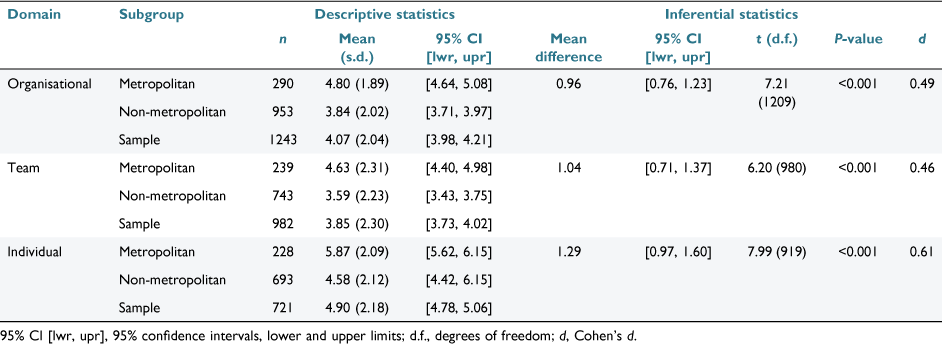
|
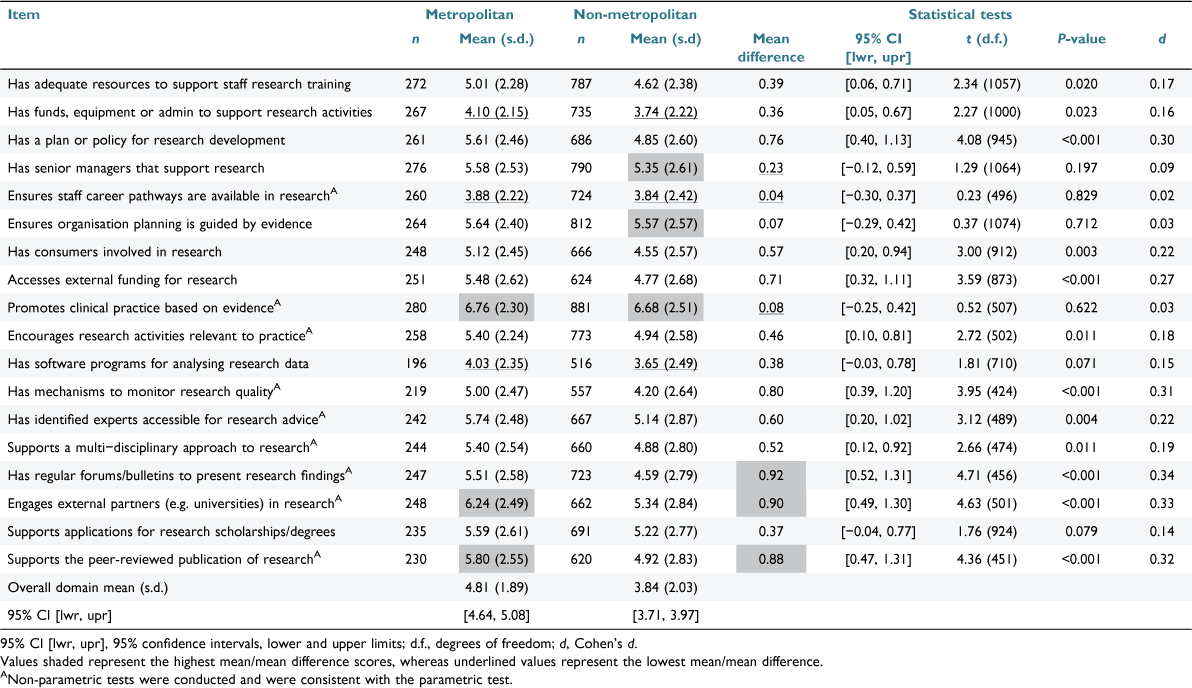
|

|
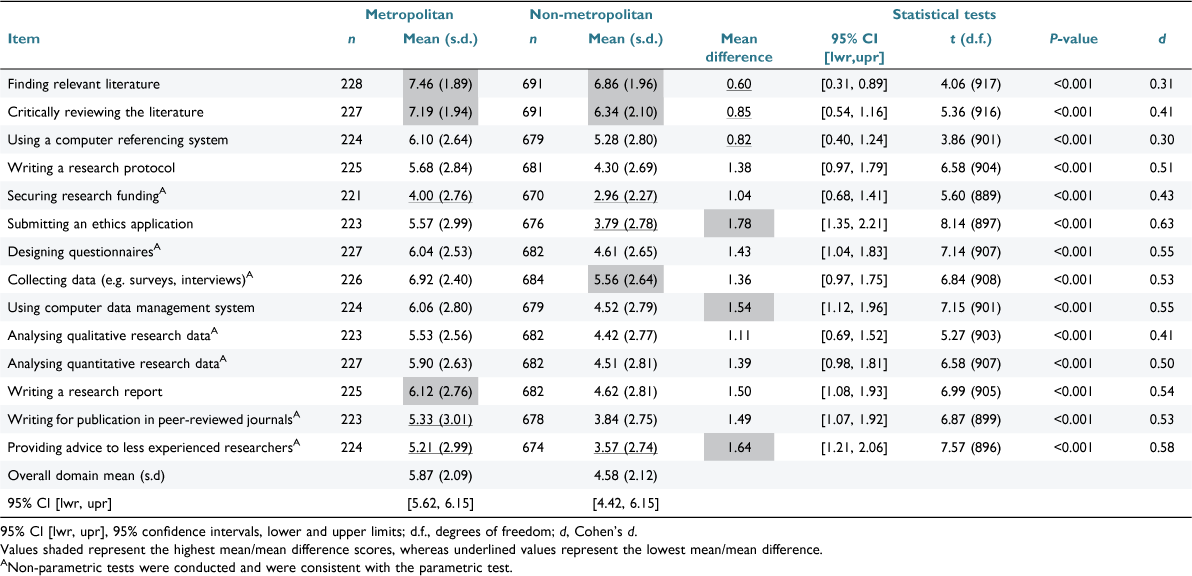
|
In summary, the domain means for the sample (NSW) and for each subgroup are displayed in Fig. 2. Overall, for all domains, non-metropolitan participants selected a higher proportion of unsure responses than their metropolitan counterparts. Additional details are available in the supplementary data tables (Supplementary Tables S1–S3). Further graphical representations of each of the domains and subgroups are available in the supplementary material (Supplementary Figs S1–S3).
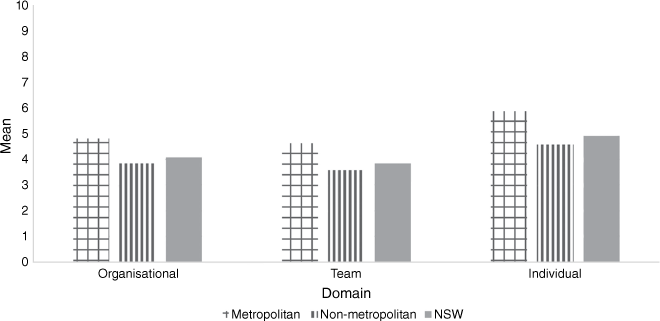
|
Discussion
Metropolitan NSW LHD staff had significantly higher perceptions of RCC than those from non-metropolitan areas across all three domains. Only two other studies have compared metropolitan with non-metropolitan areas in Victoria23 and Queensland,24 both finding a metropolitan location to influence RCC. Skills in research are vital in non-metropolitan areas to develop and test innovative solutions directly relevant to the local context, with the aim of addressing the disparity of health behaviours and outcomes between the two locations.25 Therefore, these results further add to the evidence of the gap of perceived RCC and suggests this issue may be widespread across the Australian public healthcare context.
Formalised conjoint appointments between universities and healthcare organisations and dedicated embedded clinical research positions have been shown to provide access to experienced researchers, research skills development, opportunities to participate in research activities,26–28 knowledge brokering activities29 and the encouragement of post-graduate qualifications.30 Additionally, collaboration between academia and industry is increasingly becoming a requirement of funding bodies such as the NHMRC and NSW Ministry of Health, with the view of improved relevance and translatability of findings.31,32 Such relationships may afford access to additional funding opportunities and the delivery of training to build research capacity, culture, and capability within healthcare organisations. However, the measure of success for these positions is problematic, with reports focusing on traditional academic research outputs (e.g. building collaborations and increasing research activities), rather than the translation of findings into practice.33 This may be because knowledge brokering,29 translational and implementational activities are more complex to measure. Furthermore, concerns regarding reporting lines, role expectations and measure of research outputs have been raised.33 Regardless of the type of appointment, these embedded positions have potential to deliver benefits for both organisations and ultimately patient outcomes, but should be clearly defined and structured at the outset.
Frameworks for research capacity building (RCB) invariably include the development or enhancement of research knowledge, skills, and confidence.34–38 The skills required to conduct research lie at the individual level. However, to build those skills, strategies need to be implemented at the team and/or organisational level. Building skills and confidence of individuals may require a needs assessment to ascertain the current level and gaps.39 At the team level, strategies to address gaps may include mentorship from more experienced researchers within the team to transfer knowledge and foster a culture of research.40 Non-metropolitan areas, however, face challenges with geographical spread of staff and facilities39 and sufficient experienced clinician-researchers to provide this mentoring function. Organisationally, a dedicated budget to develop targeted training based on gaps may be implemented to increase individual skills. Structured programs such as the Rural Research Capacity Building Program41 addresses many of the resource and mentoring limitations25,42 for non-metropolitan healthcare workers; however, it is limited in its reach both geographically and to the number of participants it can accommodate.
Considering the findings from this study, both metropolitan and non-metropolitan participants perceived a lack of sufficient support for research in the form of funding, software, equipment and administration at both the organisational and team level. Participants also rated a career pathway in research to be low at the organisational level. At the team level, metropolitan participants perceived incentives and support for mentoring activities to be the third lowest, whereas non-metropolitan participants rated team level planning for research development as the third lowest. A focus on these identified strategies at both the organisational and team level may well help to build individual skills and foster a culture of research within teams and across the organisation.
Strengths and limitations
This is the largest of the current literature to use the RCCT in Australia. All but three27,43–45 studies using this tool were conducted in Australia. This study was significant in its reach across one state within Australia, NSW, and its perspective of capturing multiple professions and the comparison of metropolitan with non-metropolitan public healthcare organisations. Health system factors in other states may differ resulting in contrasting findings.
Limitations include the sampling method, which aimed to recruit all eligible staff but ultimately resulted in a non-random sample with self-selection of participants. Those LHDs that distributed the email invitation to all staff rather than relying on accessing the link from another site had higher participation levels. The NSWNMA was approached to broaden the reach of participants but no other professional associations were contacted, which may have limited recruitment.
Selection bias is a frequently reported limitation in studies using the RCCT,20,22,24 with those with an interest in research more likely to respond. Furthermore, the response rate was unable to be calculated as the denominator of research-eligible staff exposure to the invitation was not able to be accurately determined. Additionally, not all metropolitan LHDs participated in this survey. The RCCT had recently been used within several metropolitan LHDs, which may account for the lack of interest from participating LHDs to subject staff to the survey again.15,46,47
Implications for future research
Future studies may explore alternative sampling methods for recruitment of participants to address the sampling bias. Targeting recruitment to select staffing groups and/or random sampling may enable the calculation of a response rate and may increase generalisability of results. However, across organisations, this method would likely require a greater level of local administrative support to the lead researcher due to privacy concerns and access to staff email lists.
Further exploration of the differences between and within professional groups may provide useful insight. This may assist targeting capacity-building strategies based on the individual needs of these groups. Future research should consider the use of interviews and/or focus groups to intensify the understanding of the concepts and findings from this study.
The findings of the current research may provide a benchmark for a longitudinal study across NSW LHDs of RCB strategies. This would be particularly helpful for non-metropolitan LHDs where strategies generally are still in their relative infancy in comparison to larger metropolitan LHDs. Additionally, studies may explore the influence of participating in research activities as a recruitment and retention strategy, which has recently been shown by Cosgrave.48 Further and more broadly, longitudinal studies may provide insight into the relationships between research capacity and research activity over time.
Conclusion
Within this sample, NSW LHD staff rated their own level of research skill higher when compared to the perception of RCC at both the organisational and team level. Further, staff from metropolitan LHDs perceived the level of RCC across all domains to be higher than non-metropolitan LHDs. These important findings provide preliminary empirical evidence that a research culture in non-metropolitan is lagging behind metropolitan LHDs.
The implications of the findings of this research suggest that an overall approach to research capacity development strategies should be holistic in seeking to integrate and target individual, team, organisational and supra-organisational or systems (i.e. state) levels. Factors that were found to be consistently low across the state, such as resources to support research activities and career pathways, may be suggestive of prioritisation for further investigation and implementation at the state and/or national level.
Supplementary material
Supplementary material is available online.
Data availability
The data that support this study will be shared upon reasonable request to the corresponding author.
Conflicts of interest
The authors declare that they have no conflicts of interest.
Declaration of funding
This research did not receive any specific funding.
References
[1] Australian Institute of Health and Welfare. Australia’s Health 2018. Canberra: Department of Health; 2018. Contract No.: Cat No.AUS 221.[2] Australian Institute of Health and Welfare. Rural & remote health: Web Report. Canberra: Australian Institute of Health and Welfare, Department of Health; 2019.
[3] Australian Institute of Health and Welfare. Rural, regional and remote health: indicators of health status and determinants of health. Canberra: Australian Institute of Health and Welfare, Department of Health; 2008.
[4] Rural Health Standing Committee. National Strategic Framework for Rural and Remote Health. Canberra: Department of Health; 2011.
[5] Australian Institute of Health and Welfare. Australia’s health 2014. Canberra: Australian Institute of Health and Welfare; 2014. Available at http://www.aihw.gov.au/WorkArea/DownloadAsset.aspx?id=60129548150 [verified 24 May 2017].
[6] Australian Institute of Health and Welfare. Australia’s health 2016. Canberra: Commonwealth of Australia, Department of Health; 2016.
[7] Russell L. Economics of rural healthcare – what works? 2017. Available at https://insightplus.mja.com.au/2017/17/economics-of-rural-health-care-what-works/ [verified 29 December 2020].
[8] Goodridge D, Marciniuk D. Rural and remote care: Overcoming the challenges of distance. Chron Respir Dis 2016; 13 192–203.
| Rural and remote care: Overcoming the challenges of distance.Crossref | GoogleScholarGoogle Scholar |
[9] Mason J. Review of Australian Government Health Workforce Programs. Canberra: Australian Government, Department of Health; 2013.
[10] Department of Health (Australia). Report on the Audit of Health Workforce in Rural and Regional Australia. Canberra: Australian Government; 2008.
[11] Barclay L, Phillips A, Lyle D. Rural and remote health research: Does the investment match the need? Aust J Rural Health 2018; 26 74–9.
| Rural and remote health research: Does the investment match the need?Crossref | GoogleScholarGoogle Scholar |
[12] Strasser R. Rural health around the world: challenges and solutions. Fam Pract 2003; 20 457–63.
| Rural health around the world: challenges and solutions.Crossref | GoogleScholarGoogle Scholar |
[13] NSW Ministry of Health. Annual Report 2018-2019. Sydney: NSW Health; 2019. Available at https://www.health.nsw.gov.au/annualreport/Publications/annual-report-2019.pdf [verified 20 September 2020].
[14] Holden L, Pager S, Golenko X, Ware RS. Validation of the research capacity and culture (RCC) tool: measuring RCC at individual, team and organisation levels. Aust J Prim Health 2012; 18 62–7.
| Validation of the research capacity and culture (RCC) tool: measuring RCC at individual, team and organisation levels.Crossref | GoogleScholarGoogle Scholar |
[15] Alison JA, Zafiropoulos B, Heard R. Key factors influencing allied health research capacity in a large Australian metropolitan health district. J Multidiscip Healthc 2017; 10 277–91.
| Key factors influencing allied health research capacity in a large Australian metropolitan health district.Crossref | GoogleScholarGoogle Scholar |
[16] Matus J, Wenke R, Hughes I, Mickan S. Evaluation of the research capacity and culture of allied health professionals in a large regional public health service. J Multidiscip Healthc 2019; 12 83–96.
| Evaluation of the research capacity and culture of allied health professionals in a large regional public health service.Crossref | GoogleScholarGoogle Scholar |
[17] IBM Corp. IBM SPSS Statistics for Macintosh, Version 26.0. Armonk, NY: IBM Corp; 2019.
[18] Friesen EL, Comino EJ, Reath J, Derrett A, Johnson M, Davies GP, et al. Building research capacity in south-west Sydney through a Primary and Community Health Research Unit. Aust J Prim Health 2014; 20 4–8.
| Building research capacity in south-west Sydney through a Primary and Community Health Research Unit.Crossref | GoogleScholarGoogle Scholar |
[19] Wenke R, Weir KA, Noble C, Mahoney J, Mickan S. Not enough time for research? Use of supported funding to promote allied health research activity. J Multidiscip Healthc 2018; 11 269–77.
| Not enough time for research? Use of supported funding to promote allied health research activity.Crossref | GoogleScholarGoogle Scholar |
[20] Wenke RJ, Mickan S, Bisset L. A cross sectional observational study of research activity of allied health teams: is there a link with self-reported success, motivators and barriers to undertaking research? BMC Health Serv Res 2017; 17 114
| A cross sectional observational study of research activity of allied health teams: is there a link with self-reported success, motivators and barriers to undertaking research?Crossref | GoogleScholarGoogle Scholar |
[21] McBride KE, Young JM, Bannon PG, Solomon MJ. Assessing surgical research at the teaching hospital level. ANZ J Surg 2017; 87 70–5.
| Assessing surgical research at the teaching hospital level.Crossref | GoogleScholarGoogle Scholar |
[22] Gill SD, Gwini SM, Otmar R, Lane SE, Quirk F, Fuscaldo G. Assessing research capacity in Victoria’s south-west health service providers. Aust J Rural Health 2019; 27 505–13.
| Assessing research capacity in Victoria’s south-west health service providers.Crossref | GoogleScholarGoogle Scholar |
[23] Williams C, Miyazaki K, Borkowski D, McKinstry C, Cotchet M, Haines T. Research capacity and culture of the Victorian public health allied health workforce is influenced by key research support staff and location. Aust Health Rev 2015; 39 303–11.
| Research capacity and culture of the Victorian public health allied health workforce is influenced by key research support staff and location.Crossref | GoogleScholarGoogle Scholar |
[24] Howard AJ, Ferguson M, Wilkinson P, Campbell KL. Involvement in research activities and factors influencing research capacity among dietitians. J Hum Nutr Diet 2013; 26 180–7.
| Involvement in research activities and factors influencing research capacity among dietitians.Crossref | GoogleScholarGoogle Scholar |
[25] Schmidt DD, Webster E, Duncanson K. Building research experience: Impact of a novice researcher development program for rural health workers. Aust J Rural Health 2019; 27 392–7.
| Building research experience: Impact of a novice researcher development program for rural health workers.Crossref | GoogleScholarGoogle Scholar |
[26] Harvey D, Plummer D, Nielsen I, Adams R, Pain T. Becoming a clinician researcher in allied health. Aust Health Rev 2016; 40 562–9.
| Becoming a clinician researcher in allied health.Crossref | GoogleScholarGoogle Scholar |
[27] Boyd M, Gall SB, Rothpletz-Puglia P, Parrott JS, King C, Byham-Gray L. Characteristics and Drivers of the Registered Dietitian Nutritionist’s Sustained Involvement in Clinical Research Activities: A Mixed Methods Study. J Acad Nutr Diet 2019; 119 2099–108.
| Characteristics and Drivers of the Registered Dietitian Nutritionist’s Sustained Involvement in Clinical Research Activities: A Mixed Methods Study.Crossref | GoogleScholarGoogle Scholar |
[28] Mickan S, Coates D. Embedded researchers’ purpose and practice: Current perspectives from Australia. Int J Health Plann Manage 2022; 37 133–42.
| Embedded researchers’ purpose and practice: Current perspectives from Australia.Crossref | GoogleScholarGoogle Scholar |
[29] Bornbaum CC, Kornas K, Peirson L, Rosella LC. Exploring the function and effectiveness of knowledge brokers as facilitators of knowledge translation in health-related settings: a systematic review and thematic analysis. Implement Sci 2015; 10 162
| Exploring the function and effectiveness of knowledge brokers as facilitators of knowledge translation in health-related settings: a systematic review and thematic analysis.Crossref | GoogleScholarGoogle Scholar |
[30] Faulkner-Gurstein R, Jones HC, McKevitt C. “Like a nurse but not a nurse”: Clinical Research Practitioners and the evolution of the clinical research delivery workforce in the NHS. Health Res Policy Syst 2019; 17 59
| “Like a nurse but not a nurse”: Clinical Research Practitioners and the evolution of the clinical research delivery workforce in the NHS.Crossref | GoogleScholarGoogle Scholar |
[31] Commonwealth of Australia. Medical Research Future Fund: Australia medical research and innovation strategy 2016-2021. Canberra: Australian Government; 2016.
[32] NSW Ministry of Health. Translational Research Grant Scheme. Sydney: Office of Health and Medical Research; 2020. Available at https://www.medicalresearch.nsw.gov.au/translational-research-grants-scheme/ [verified 1 November 2020].
[33] Coates D, Mickan S. The embedded researcher model in Australian healthcare settings: comparison by degree of “embeddedness”. Transl Res 2020; 218 29–42.
| The embedded researcher model in Australian healthcare settings: comparison by degree of “embeddedness”.Crossref | GoogleScholarGoogle Scholar |
[34] Slade SC, Philip K, Morris ME. Frameworks for embedding a research culture in allied health practice: a rapid review. Health Res Policy Syst 2018; 16 29
| Frameworks for embedding a research culture in allied health practice: a rapid review.Crossref | GoogleScholarGoogle Scholar |
[35] Cooke J. A framework to evaluate research capacity building in health care. BMC Fam Pract 2005; 6 44
| A framework to evaluate research capacity building in health care.Crossref | GoogleScholarGoogle Scholar |
[36] Matus J, Walker A, Mickan S. Research capacity building frameworks for allied health professionals – a systematic review. BMC Health Serv Res 2018; 18 716
| Research capacity building frameworks for allied health professionals – a systematic review.Crossref | GoogleScholarGoogle Scholar |
[37] Gullick JG, West SH. Building research capacity and productivity among advanced practice nurses: an evaluation of the Community of Practice model. J Adv Nurs 2016; 72 605–19.
| Building research capacity and productivity among advanced practice nurses: an evaluation of the Community of Practice model.Crossref | GoogleScholarGoogle Scholar |
[38] Smith H, Wright D, Morgan S, Dunleavey J, Moore M. The ‘Research Spider’: a simple method of assessing research experience. Prim Health Care Res Dev 2002; 3 139–40.
| The ‘Research Spider’: a simple method of assessing research experience.Crossref | GoogleScholarGoogle Scholar |
[39] Schmidt D, Reyment J, Webster E, Kirby S, Lyle D. Workplace-based health research training: a qualitative study of perceived needs in a rural setting. Health Res Policy Syst 2020; 18 67
| Workplace-based health research training: a qualitative study of perceived needs in a rural setting.Crossref | GoogleScholarGoogle Scholar |
[40] Byars-Winston AM, Branchaw J, Pfund C, Leverett P, Newton J. Culturally Diverse Undergraduate Researchers’ Academic Outcomes and Perceptions of Their Research Mentoring Relationships. Int J Sci Educ 2015; 37 2533–54.
| Culturally Diverse Undergraduate Researchers’ Academic Outcomes and Perceptions of Their Research Mentoring Relationships.Crossref | GoogleScholarGoogle Scholar |
[41] NSW Health and Education Institute. Rural Research Capacity Building Program. 2022. Available at https://www.heti.nsw.gov.au/education-and-training/courses-and-programs/rural-research-capacity-building-program [verified 7 September 2022].
[42] Duncanson K, Webster EL, Schmidt DD. Impact of a remotely delivered, writing for publication program on publication outcomes of novice researchers. Rural Remote Health 2018; 18 4468
| Impact of a remotely delivered, writing for publication program on publication outcomes of novice researchers.Crossref | GoogleScholarGoogle Scholar |
[43] Luckson M, Duncan F, Rajai A, Haigh C. Exploring the research culture of nurses and allied health professionals (AHPs) in a research-focused and a non-research-focused healthcare organisation in the UK. J Clin Nurs 2018; 27 e1462–76.
| Exploring the research culture of nurses and allied health professionals (AHPs) in a research-focused and a non-research-focused healthcare organisation in the UK.Crossref | GoogleScholarGoogle Scholar |
[44] Becker D, Garth H, Hollander R, Klein F, Klau M. Understanding Faculty and Trainee Needs Related to Scholarly Activity in a Large, Nonuniversity Graduate Medical Education Program. Perm J 2017; 21 16-034
| Understanding Faculty and Trainee Needs Related to Scholarly Activity in a Large, Nonuniversity Graduate Medical Education Program.Crossref | GoogleScholarGoogle Scholar |
[45] Gimeno H, Alderson L, Waite G, Chugh D, O’Connor G, Pepper L, et al. Frontline Allied Health Professionals in a Tertiary Children’s Hospital: Moving Forward Research Capacity, Culture and Engagement. Int J Pract-Based Learn Health Soc Care 2021; 9 29–49.
| Frontline Allied Health Professionals in a Tertiary Children’s Hospital: Moving Forward Research Capacity, Culture and Engagement.Crossref | GoogleScholarGoogle Scholar |
[46] Lee SA, Byth K, Gifford JA, Balasubramanian M, Fozzard CA, Skapetis T, et al. Assessment of Health Research Capacity in Western Sydney Local Health District (WSLHD): A Study on Medical, Nursing and Allied Health Professionals. J Multidiscip Healthc 2020; 13 153–63.
| Assessment of Health Research Capacity in Western Sydney Local Health District (WSLHD): A Study on Medical, Nursing and Allied Health Professionals.Crossref | GoogleScholarGoogle Scholar |
[47] Friesen EL, Comino EJ. Research culture and capacity in community health services: results of a structured survey of staff. Aust J Prim Health 2016; 23 123–31.
| Research culture and capacity in community health services: results of a structured survey of staff.Crossref | GoogleScholarGoogle Scholar |
[48] Cosgrave C. Context Matters: Findings from a Qualitative Study Exploring Service and Place Factors Influencing the Recruitment and Retention of Allied Health Professionals in Rural Australian Public Health Services. Int J Environ Res Public Health 2020; 17 5815
| Context Matters: Findings from a Qualitative Study Exploring Service and Place Factors Influencing the Recruitment and Retention of Allied Health Professionals in Rural Australian Public Health Services.Crossref | GoogleScholarGoogle Scholar |


